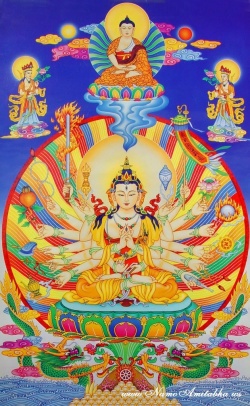Vehicles and Paths
It appears that the distinction between vehicles and paths arises in early Mahayana sutras, such as the Lotus Sutra, where it is stated that there is one path - the path to Nirvana -, but there are different vehicles. In this sense, the vehicles are described as representing the fruit of three types of Buddha found in Nikaya sutras, as mentioned above. For instance, in Chapter three of the Lotus Sutra, there is a parable of a father promising three carts to lure sons out of a burning building, where the goat-cart represents Sravaka-Buddhahood; the deer-cart, Pratyeka-Buddhahood; and the bullock-cart, Samyaksam-Buddhahood.
The Lotus Sutra (Ch.3) declares: "Though he (the Buddha) has power and fearlessness, he does no use them, but only by his wise tact does he remove and save all living creatures from the burning house of the triple world (a Buddhist term for Samsara), teaching the three vehicles: the sravaka-buddha, pratyeka-buddha, and samyaksam-buddha vehicles."
This quote tells us something more about early Mahayana views: That it is the vehicles that are taught as a method for journeying on the path to enlightenment. It is here that we can see the basis for term being used to indicate differences of doctrine.
The Lotus Sutra (Ch.3) continues: "Know this! All these three vehicles are praised by sages; [in them you will be] free and independant, without wanting to rely on anything else. [...]
If there are beings who [...] desire speedily to escape from the triple world and seek nirvana for themselves, these will have the vehicle named the 'sravakayana', just as some of those children come out of the house for the sake of a goat cart.
If there are beings who [...] seek self-gained wisdom, delighting in the tranquility of their individual goodness, these will have the vehicle named the 'pratyekayana', just as some of those children come out of the house for the sake of a deer cart.
If there are beings who [...] seek the wisdom without a teacher, who take pity on and comfort innumerable creatures, benefiting gods and men, and save all beings, these will have the vehicle named the 'mahayana', just as some of those children come out of the house for the sake of a goat cart."
The Sutra then continues, declaring that the bullock-cart is "supremely restful", implying that the goat-cart and the deer-cart are inferior to the bullock-cart. This is where we begin to see the terminological origins for the term Hinayana: The Sravakayana and the Pratyekayana as vehicles inferior to the superior bullock-cart of the Mahayana.
The Lotus Sutra therefore makes the distinction between the vehicles according to the type of Buddha that arises, and all Buddhists agree that a Samyaksam-Buddha is superior to a Sravaka-Buddha or a Pratyeka-Buddha, at least on the basis that only a Samyaksam-Buddha can teach the Dharma where (or when) it has not been taught before.

